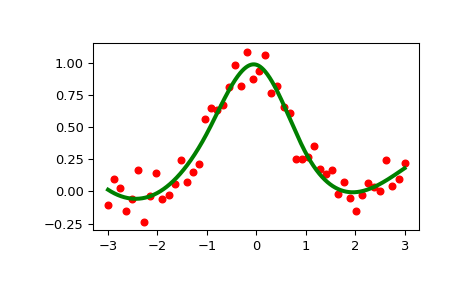scipy.interpolate.LSQUnivariateSpline¶
-
class
scipy.interpolate.LSQUnivariateSpline(x, y, t, w=None, bbox=[None, None], k=3, ext=0, check_finite=False)[source]¶ One-dimensional spline with explicit internal knots.
Fits a spline y = spl(x) of degree k to the provided x, y data. t specifies the internal knots of the spline
- Parameters
- x(N,) array_like
Input dimension of data points – must be increasing
- y(N,) array_like
Input dimension of data points
- t(M,) array_like
interior knots of the spline. Must be in ascending order and:
bbox[0] < t[0] < ... < t[-1] < bbox[-1]
- w(N,) array_like, optional
weights for spline fitting. Must be positive. If None (default), weights are all equal.
- bbox(2,) array_like, optional
2-sequence specifying the boundary of the approximation interval. If None (default),
bbox = [x[0], x[-1]].- kint, optional
Degree of the smoothing spline. Must be 1 <= k <= 5. Default is k=3, a cubic spline.
- extint or str, optional
Controls the extrapolation mode for elements not in the interval defined by the knot sequence.
if ext=0 or ‘extrapolate’, return the extrapolated value.
if ext=1 or ‘zeros’, return 0
if ext=2 or ‘raise’, raise a ValueError
if ext=3 of ‘const’, return the boundary value.
The default value is 0.
- check_finitebool, optional
Whether to check that the input arrays contain only finite numbers. Disabling may give a performance gain, but may result in problems (crashes, non-termination or non-sensical results) if the inputs do contain infinities or NaNs. Default is False.
- Raises
- ValueError
If the interior knots do not satisfy the Schoenberg-Whitney conditions
See also
UnivariateSplineSuperclass – knots are specified by setting a smoothing condition
InterpolatedUnivariateSplinespline passing through all points
splrepAn older, non object-oriented wrapping of FITPACK
splev,sproot,splint,spaldeBivariateSplineA similar class for two-dimensional spline interpolation
Notes
The number of data points must be larger than the spline degree k.
Knots t must satisfy the Schoenberg-Whitney conditions, i.e., there must be a subset of data points
x[j]such thatt[j] < x[j] < t[j+k+1], forj=0, 1,...,n-k-2.Examples
>>> from scipy.interpolate import LSQUnivariateSpline, UnivariateSpline >>> import matplotlib.pyplot as plt >>> x = np.linspace(-3, 3, 50) >>> y = np.exp(-x**2) + 0.1 * np.random.randn(50)
Fit a smoothing spline with a pre-defined internal knots:
>>> t = [-1, 0, 1] >>> spl = LSQUnivariateSpline(x, y, t)
>>> xs = np.linspace(-3, 3, 1000) >>> plt.plot(x, y, 'ro', ms=5) >>> plt.plot(xs, spl(xs), 'g-', lw=3) >>> plt.show()

Check the knot vector:
>>> spl.get_knots() array([-3., -1., 0., 1., 3.])
Constructing lsq spline using the knots from another spline:
>>> x = np.arange(10) >>> s = UnivariateSpline(x, x, s=0) >>> s.get_knots() array([ 0., 2., 3., 4., 5., 6., 7., 9.]) >>> knt = s.get_knots() >>> s1 = LSQUnivariateSpline(x, x, knt[1:-1]) # Chop 1st and last knot >>> s1.get_knots() array([ 0., 2., 3., 4., 5., 6., 7., 9.])
Methods
__call__(self, x[, nu, ext])Evaluate spline (or its nu-th derivative) at positions x.
antiderivative(self[, n])Construct a new spline representing the antiderivative of this spline.
derivative(self[, n])Construct a new spline representing the derivative of this spline.
derivatives(self, x)Return all derivatives of the spline at the point x.
get_coeffs(self)Return spline coefficients.
get_knots(self)Return positions of interior knots of the spline.
get_residual(self)Return weighted sum of squared residuals of the spline approximation.
integral(self, a, b)Return definite integral of the spline between two given points.
roots(self)Return the zeros of the spline.
set_smoothing_factor(self, s)Continue spline computation with the given smoothing factor s and with the knots found at the last call.
